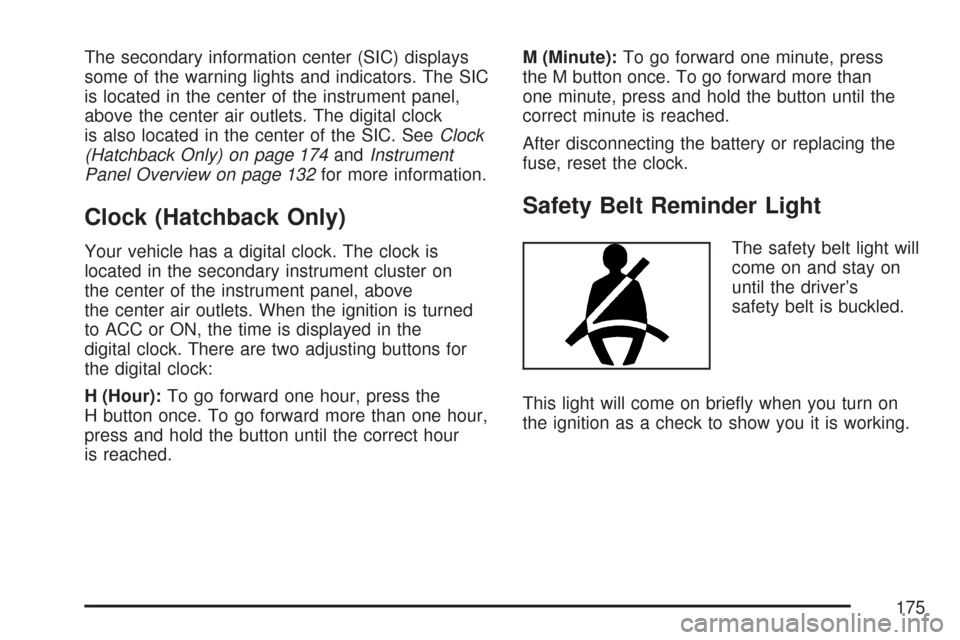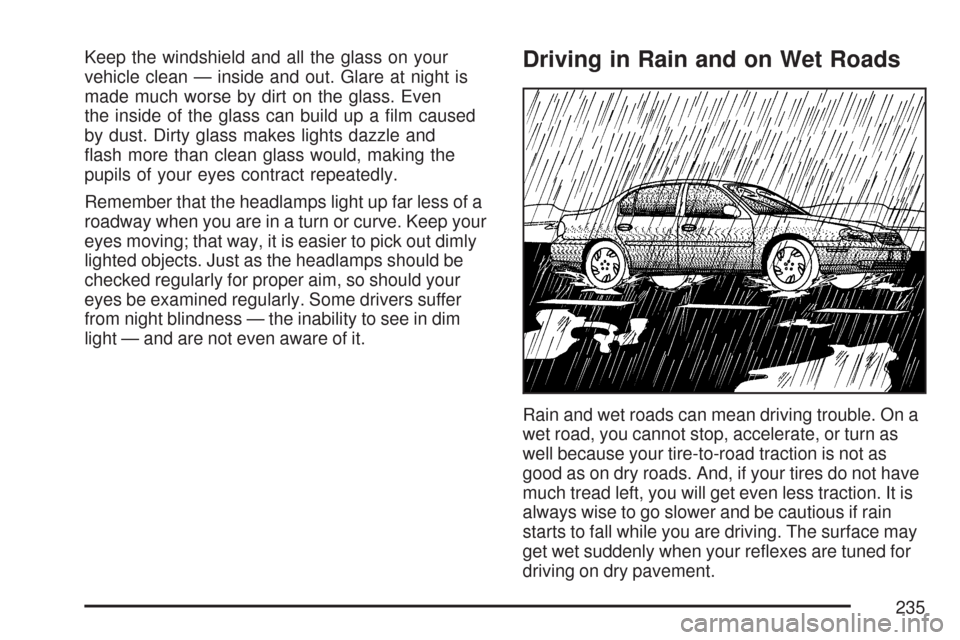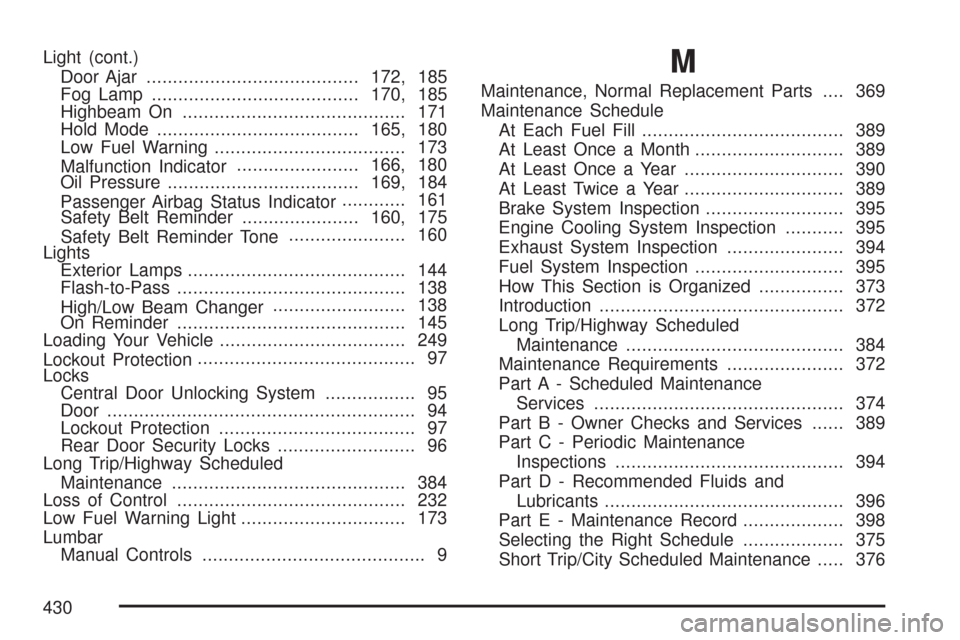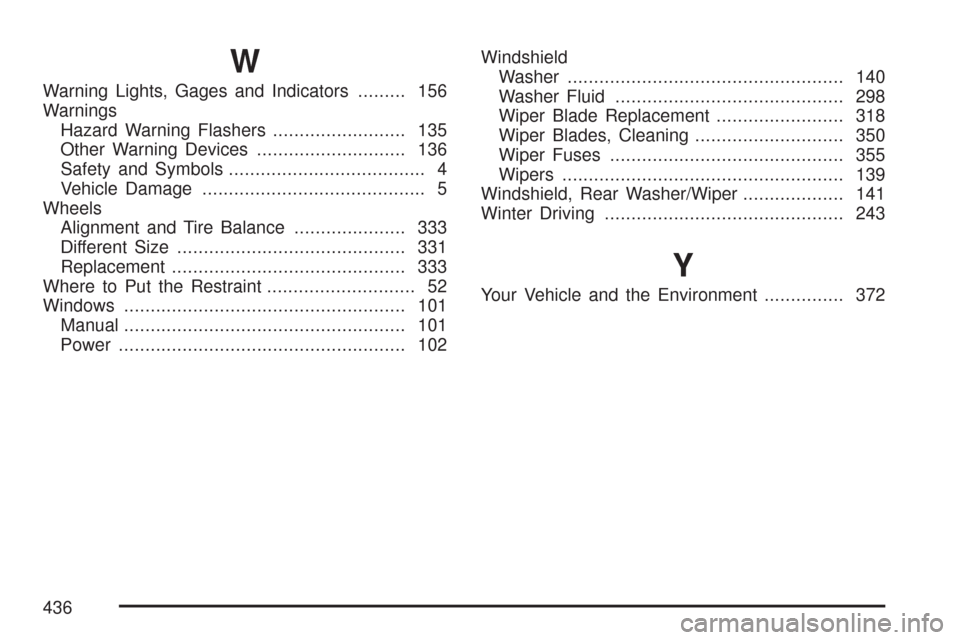Page 156 of 436

Warning Lights, Gages, and
Indicators
This part describes the warning lights and gages on
your vehicle. The pictures help to locate them.
Warning lights and gages can signal that something
is wrong before it becomes serious enough to
cause an expensive repair or replacement. Paying
attention to the warning lights and gages could also
save you or others from injury.
Warning lights come on when there may be or is a
problem with one of your vehicle’s functions. As
the details show on the next few pages, some
warning lights come on briefly when you start the
engine just to let you know they are working. If
you are familiar with this section, you should
not be alarmed when this happens.
Gages can indicate when there may be or is a
problem with one of your vehicle’s functions. Often
gages and warning lights work together to let you
know when there is a problem with your vehicle.When one of the warning lights comes on and
stays on as you are driving, or when one of
the gages shows there may be a problem, check
the section that tells you what to do about it.
Please follow this manual’s advice. Waiting to do
repairs can be costly and even dangerous. So
please get to know your vehicle’s warning
lights and gages. They can be a big help.
Instrument Panel Cluster
Your instrument panel cluster is designed to let you
know at a glance how your vehicle is running. You
will know how fast you are going, how much fuel
you are using, and many other things you will need
to drive safely and economically.
156
Page 157 of 436
Your vehicle’s instrument panel cluster includes indicator warning lights and gages that are explained on
the following pages.
United States Hatchback shown, Canada Hatchback similar
157
Page 175 of 436

The secondary information center (SIC) displays
some of the warning lights and indicators. The SIC
is located in the center of the instrument panel,
above the center air outlets. The digital clock
is also located in the center of the SIC. SeeClock
(Hatchback Only) on page 174andInstrument
Panel Overview on page 132for more information.
Clock (Hatchback Only)
Your vehicle has a digital clock. The clock is
located in the secondary instrument cluster on
the center of the instrument panel, above
the center air outlets. When the ignition is turned
to ACC or ON, the time is displayed in the
digital clock. There are two adjusting buttons for
the digital clock:
H (Hour):To go forward one hour, press the
H button once. To go forward more than one hour,
press and hold the button until the correct hour
is reached.M (Minute):To go forward one minute, press
the M button once. To go forward more than
one minute, press and hold the button until the
correct minute is reached.
After disconnecting the battery or replacing the
fuse, reset the clock.
Safety Belt Reminder Light
The safety belt light will
come on and stay on
until the driver’s
safety belt is buckled.
This light will come on briefly when you turn on
the ignition as a check to show you it is working.
175
Page 235 of 436

Keep the windshield and all the glass on your
vehicle clean — inside and out. Glare at night is
made much worse by dirt on the glass. Even
the inside of the glass can build up a film caused
by dust. Dirty glass makes lights dazzle and
flash more than clean glass would, making the
pupils of your eyes contract repeatedly.
Remember that the headlamps light up far less of a
roadway when you are in a turn or curve. Keep your
eyes moving; that way, it is easier to pick out dimly
lighted objects. Just as the headlamps should be
checked regularly for proper aim, so should your
eyes be examined regularly. Some drivers suffer
from night blindness — the inability to see in dim
light — and are not even aware of it.Driving in Rain and on Wet Roads
Rain and wet roads can mean driving trouble. On a
wet road, you cannot stop, accelerate, or turn as
well because your tire-to-road traction is not as
good as on dry roads. And, if your tires do not have
much tread left, you will get even less traction. It is
always wise to go slower and be cautious if rain
starts to fall while you are driving. The surface may
get wet suddenly when your reflexes are tuned for
driving on dry pavement.
235
Page 287 of 436

Engine Coolant
The cooling system in your vehicle is filled with
DEX-COOL®engine coolant. This coolant is
designed to remain in your vehicle for five years
or 150,000 miles (240 000 km), whichever
occurs first, if you add only DEX-COOL
®extended
life coolant.
The following explains your cooling system and
how to add coolant when it is low. If you have
a problem with engine overheating, seeEngine
Overheating on page 290.
A 50/50 mixture of clean, drinkable water and
DEX-COOL
®coolant will:
•Give freezing protection down to
−34°F (−37°C).
•Give boiling protection up to 265°F (129°C).
•Protect against rust and corrosion.
•Help keep the proper engine temperature.
•Let the warning lights and gages work as
they should.
Notice:Using coolant other than DEX-COOL
®
may cause premature engine, heater core,
or radiator corrosion. In addition, the engine
coolant may require changing sooner, at
the �rst maintenance service after each
30,000 miles (50 000 km) or 24 months,
whichever occurs �rst. Any repairs would
not be covered by your warranty. Always
use DEX-COOL
®(silicate-free) coolant in
your vehicle.
287
Page 430 of 436

Light (cont.)
Door Ajar........................................172, 185
Fog Lamp.......................................170, 185
Highbeam On.......................................... 171
Hold Mode......................................165, 180
Low Fuel Warning.................................... 173
Malfunction Indicator.......................166, 180
Oil Pressure....................................169, 184
Passenger Airbag Status Indicator............ 161
Safety Belt Reminder......................160, 175
Safety Belt Reminder Tone...................... 160
Lights
Exterior Lamps......................................... 144
Flash-to-Pass........................................... 138
High/Low Beam Changer......................... 138
On Reminder........................................... 145
Loading Your Vehicle................................... 249
Lockout Protection......................................... 97
Locks
Central Door Unlocking System................. 95
Door.......................................................... 94
Lockout Protection..................................... 97
Rear Door Security Locks.......................... 96
Long Trip/Highway Scheduled
Maintenance............................................ 384
Loss of Control........................................... 232
Low Fuel Warning Light............................... 173
Lumbar
Manual Controls.......................................... 9M
Maintenance, Normal Replacement Parts.... 369
Maintenance Schedule
At Each Fuel Fill...................................... 389
At Least Once a Month............................ 389
At Least Once a Year.............................. 390
At Least Twice a Year.............................. 389
Brake System Inspection.......................... 395
Engine Cooling System Inspection........... 395
Exhaust System Inspection...................... 394
Fuel System Inspection............................ 395
How This Section is Organized................ 373
Introduction.............................................. 372
Long Trip/Highway Scheduled
Maintenance......................................... 384
Maintenance Requirements...................... 372
Part A - Scheduled Maintenance
Services............................................... 374
Part B - Owner Checks and Services...... 389
Part C - Periodic Maintenance
Inspections........................................... 394
Part D - Recommended Fluids and
Lubricants............................................. 396
Part E - Maintenance Record................... 398
Selecting the Right Schedule................... 375
Short Trip/City Scheduled Maintenance..... 376
430
Page 436 of 436

W
Warning Lights, Gages and Indicators......... 156
Warnings
Hazard Warning Flashers......................... 135
Other Warning Devices............................ 136
Safety and Symbols..................................... 4
Vehicle Damage.......................................... 5
Wheels
Alignment and Tire Balance..................... 333
Different Size........................................... 331
Replacement............................................ 333
Where to Put the Restraint............................ 52
Windows..................................................... 101
Manual..................................................... 101
Power...................................................... 102Windshield
Washer.................................................... 140
Washer Fluid........................................... 298
Wiper Blade Replacement........................ 318
Wiper Blades, Cleaning............................ 350
Wiper Fuses............................................ 355
Wipers..................................................... 139
Windshield, Rear Washer/Wiper................... 141
Winter Driving............................................. 243
Y
Your Vehicle and the Environment............... 372
436